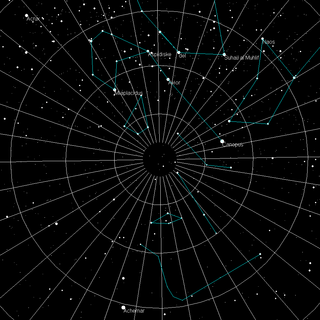Ecliptic pole
The ecliptic pole is the point on the celestial sphere where the sphere meets the imaginary line perpendicular to the ecliptic plane, the path the Earth travels on its orbit around the Sun.
There are two ecliptic poles:
 The North Ecliptic Pole is in Draco. |
 The South Ecliptic Pole is in Dorado |
Due to precession, the celestial pole moves in a circle around the ecliptic poles once every 25,800 years.
The ecliptic poles are (as of epoch 1 January 2000) at:
- (North) right ascension 18h 0m 0.0s (exact), declination +66° 33′ 38.55″
- (South) right ascension 6h 0m 0.0s (exact), declination −66° 33′ 38.55″
when expressed in equatorial coordinates, as a consequence of the Earth's axial tilt.
It is not possible to have the ecliptic poles at the zenith in a dark sky. By definition, the ecliptic poles are located 90 degrees from the Sun's position. Therefore, whenever either ecliptic pole is at the zenith, the Sun must be on the horizon. Ecliptic poles can be in zenith at Arctic and Antarctic Circle.